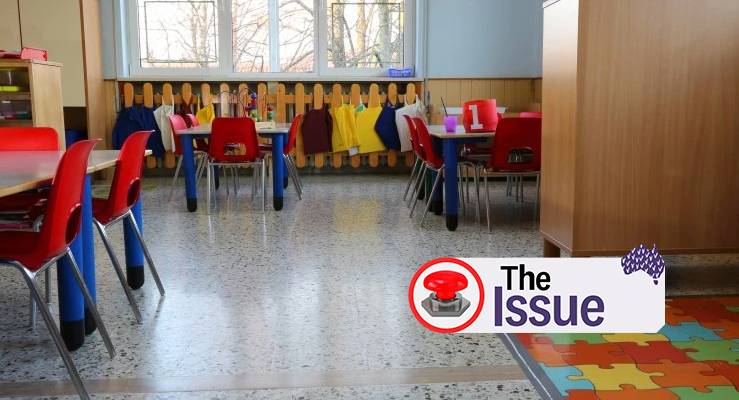
Brendan Ryan is a financial adviser working in the aged care and childcare sectors. He’s crunched the numbers for which party offers the best childcare deal. The results are a little bit of a surprise. He explains his finding here and on his blog, entitlemate.com
It’s interesting that on any given day financial columns of newspapers will be filled with questions and technical analysis around retirement and superannuation, but the complex government rules around childcare get very little attention.
Let’s cut straight to it: Labor offers the best deal for families with one child in care, or if you have two children in care and one of them is younger than six. If this is your situation, look no further. The deal is better. How much better? Well, that depends. See the tables below. The right-hand side shows how much the difference in subsidy could be.
If your family is in a different situation, it is nowhere near as straightforward.
Earn between $355,000 and $530,000? Vote Labor
Under the Labor proposal, the childcare subsidy percentage reduces to zero at a family income of $530,000 per annum. Current Liberal policy cuts off support altogether at $355,000.
That’s a new cohort of families — those earning between $355,000 and $530,000 a year — that will get government support if Labor wins the election.
Table 1: Maximum annual childcare subsidy for one child

Maximum subsidy available for long day care per child, per year. The amount is derived by applying the applicable childcare subsidy percentage by the hourly rate cap for the maximum 100 hours per fortnight, over 52 weeks.
Source: Labor Cheaper Childcare Plan, Services Australia
Two children in care? Take a closer look
Here is where it gets interesting: two children in care under six years old.
Liberal policy — changed as of March 7 this year — means a second child (if the first one is younger than six) gets a 30% uplift in the subsidy rate, to a cap of 95%.
Under the current system, if a family earns $200,000 and has two children under six in childcare, the subsidy percentage is 50% for the first child and 80% for the second child. The average rate of subsidy for the two kids is 65%; under the Labor proposal, each child gets a flat rate of 66%.
In Table 2 you will see that for families with two children in care and whose income is less than $125,000, the maximum childcare subsidy is almost the same between the parties. In other words, vote Labor or Liberal, there’s no difference.
For families with income between $125,000 and $355,000, the best outcome depends on income — with both parties winning at different levels. Liberals, for instance, have a better deal if your family income is between about $225,000 and $325,000. Labor wins at the other levels.
Table 2: Maximum annual childcare subsidy for two children under six

Maximum subsidy available for long day care per child, per year. The amount derived by applying the applicable childcare subsidy percentage by the hourly rate cap for the maximum 100 hours per fortnight, over 52 weeks.
Source: Labor Cheaper Childcare Plan, Services Australia
Three kids in care? Vote Liberal (unless you earn over $355,000)
What about three kids? In this case, the Liberal policy is better for lower-income families with three children under six in care. In fact, the Liberal policy is going to be better for (almost) all income levels below about $355,000 if you have three kids.
The reason is the 30% increase in subsidy above the Liberal rate for the second and third child under six is high enough to beat Labor’s flat rate.
For example, a family with an income of $200,000 will qualify for a 66% rate under the Labor policy. Under the current Liberal policy, the first child qualifies for a rate of 50% and the next two children get an extra 30 percentage points — so each at 80%. The result is a higher maximum subsidy.
Table 3: Maximum annual childcare subsidy for three children under six

Maximum subsidy available for long day care per child, per year. The amount derived by applying the applicable childcare subsidy percentage by the hourly rate cap for the maximum 100 hours per fortnight, over 52 weeks.
Source: Labor Cheaper Childcare Plan, Services Australia
Subsidy is just a part of the puzzle
Governments use a formula when calculating support for childcare, with a few inputs based on your family situation. Your family income is where the percentage comes from.
The percentage is applied to an hourly cost of childcare, where the limit is currently $12.31 per hour for long daycare, and a lower amount for other kinds of care, such as family day care and before- and after-school care. About 15% of childcare providers charge above this rate per hour (and in some areas much higher), so this means the percentage rate may not go as some families hope.
There is also a limit to the number of hours the government will subsidise, which has a maximum of 100 hours per fortnight. A family may be eligible for 50 hours in a week — but may use a childcare provider that is open for 11 hours a day — meaning that a five-day week is 55 hours, more hours that the subsidy can reach.
This is all complicated stuff, and there are plenty of quirks in how individual families are impacted.
But wait, there’s more
In the tables above, we assume families have all their children in care for the same amount of time, and for the same cost.
This may not always be the case. An example would be an older child who may be in after-school care and the younger child in an expensive room, say, for babies under 12 months. What happens here?
Services Australia does the work for you to outline a number of situations where the current Liberal system can provide significant, and unexpected, benefits to families.
Here are some examples:
Older child in after-school care
If the older child (but still younger than six) is in cheaper after-school care, the younger child in centre-based childcare can take advantage of the higher subsidy. This is important to note, as this whole story is not just about having all your children in childcare centres — although the story changes once the oldest turns six.
The higher-subsidy child in care for more days
This example (from the Services Australia website) suggests that the “standard rate” child — the one with the lower rate of subsidy — may be in care for fewer days, with the younger, more-subsidised child in for longer. This means the child with the higher cost of care can also attract the higher rate of subsidy.
It is important to note that all the advantages of the present (Liberal) system disappears when the older child turns six. When this happens, the Labor policy offers the better deal.
So many parts of the system are subject to ongoing, rigorous, well-resourced analysis by professionals and the media. But this is one area that slips through the gaps.
If you are going to vote on the basis of cheaper childcare, make sure you work out which system is going to be cheaper for you.
Note: The childcare subsidy percentage is not simply applied to your childcare costs. The percentage will be applied to the lower of your hourly rate or the hourly rate cap. The number of hours that will be subsidised will be based on your activity and are capped. If you are working in areas where childcare costs are higher than $12.31 per hour, and the centres are open more than 10 hours per day, you have a whole lot of other things to consider when working out how the system supports you.








It’s a ridiculous policy – not in the sense that we shouldn’t have childcare, but in the sense that it needs to be so complicated to qualify for something that should just be universal.
As usual it was little johnny that mucked it up. The usual privatisation stuff, before that the government paid the child care centres directly for the care of children, which was changed to parents having to claim their subsidy. Meant the centres had a fair bit of grief too.
True but, as with so much which ails our society, the rot set in with those class traitors, HawKeating who destroyed the mutally supportive, friend/family/street based PLAYGROUPS which throve in the 70s/early 80s.
Then the Rodent did what he always did, moving in afterwards through the smoking ruins, killing survivors & looting.
Presumably at the behest of an unholy combination of big union pique & the flood of unemployables with PhDs in BasketWeaving & Macrame,impossible conditions were imposed on the community based groups, under the pretext of the evil Elfin Safeti with OH&S strictures and public liability insurance.
For profit child care, like aged care, medicine and other obscenities, it is a contradiction in terms.
Ludicrous discussion! A family earning $75K gets about $85 per day per child childcare subsidy no matter which party. With childcare costing upwards of $150/day that doesn’t leave much for food, let alone lifestyle, after paying their punitive, unregulated rent (because I’m assuming we’re talking about families who will probably never own their own home).
This time, instead of voting yet again for NLP or Labor hoping for a different outcome (a sure sign of madness) vote for the Greens or a sympathetic independent. The alternative is what we’ve experienced for the last 100 years and how’s that working out so far…
See, when I go into the polling booth to vote, I won’t be voting for the party/candidate who promises to do the most for *me*. I will vote for the candidate who promises to do the most for the *majority* of the Australian people. On that basis, Libs will be close to the bottom of my ballot.
Hi Brendan, really interesting article but not quite up to date. Labor has now changed its policy to match the Coalition’s second and subsequent child CCS rates. So you may need to correct this article. The Coalition has also flagged a review of the hourly fee cap this year, while Labor will ask the ACCC to develop a price regulation mechanism.
Thanks for the update. This is new to the policy from 28 March that I was using as a basis. This new development means that families with 2 or more children under 6 will start with a calculation of the Labor CCS%, then have to calculate the Coalition CCS% then add the 30% up to the limit of 95%, then compare it against the Labor percentage to see which is better. When you take into account the thresholds, percentages and taper rates, there are at least 10 components and a reasonably complex sequence of steps required to work out something extremely important to the families of the 1.4m or so children in childcare. There is a problem in that the system is so complicated, very few families have the time and resources to make informed plans. I am sure families will be grateful for this contribution to alleviating cost of living pressure – once, or if, they can get to the bottom of what childcare will actually cost them. I will recut the numbers. Thanks again.